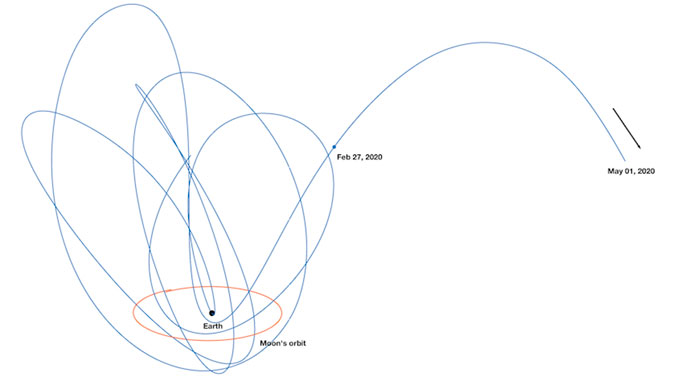Spotted earlier this year, asteroid 2020 CD3 is only the second temporary natural satellite, or minimoon, ever detected around Earth. It didn’t stick around for very long, but we learned some interesting things about our temporary companion and why a mission to intercept similar objects is a good idea.
Asteroid 2020 CD3 was first spotted by astronomers from the Catalina Sky Survey at the University of Arizona on February 15, 2020. Some preliminary calculations were made about its size and orbit, but new research published in the Astronomical Journal is providing the most definitive analysis yet of this rare minimoon.
Actually, “rare” might not be the right way to say it. More like “rarely detected.” Minimoons, or temporary natural satellites, are probably quite common — they’re just notoriously difficult to see, owing to their small size and fickle nature. But as the Institute of Astronomy (IfA) at the University of Hawai’i points out in a statement, approximately 1 in every 1,000 meteors that burn up in Earth’s atmosphere were once a minimoon. These objects aren’t big enough to cause problems on Earth’s surface, and they tend to make a few wacky loops around Earth before resuming their trek around a more persuasive object, the Sun.

Minimoons might seem mundane, but 2020 CD3 got a lot of attention; the new paper boasts 23 authors from 14 different academic institutions.
First and foremost, the new paper ruled out the lingering possibility that 2020 CD3 was a returning chunk of space junk. The object’s area-to-mass ratio and low luminosity suggest it’s a silicate asteroid, and not, for example, a discarded rocket booster or wayward Tesla roadster. The same cannot be said for a prospective minimoon detected this past September — an object strongly believed to be a Centaur second-stage rocket launched by NASA in 1966.
Asteroid 2020 CD3 is slightly smaller than the preliminary estimates. It’s about 1.2 metres wide, so it’s a bit larger than a dishwasher, and definitely bigger than a breadbox. The authors say it’s probably a fragment that broke off from a larger asteroid and that it originated somewhere between Mars and Jupiter.
“It is incredible that modern astronomical telescopes can detect minimoons the size of big boulders as far away as the Moon,” said IfA astronomer and study co-author Robert Jedicke in the University of Hawai’i statement.
The researchers were also able to characterise the object’s orbit with more precision. As it turns out, 2020 CD3 has been in minimoon mode for the past 2.5 years — we just didn’t know it. The object had been circling Earth since 2018, but it swooped in for a close approach, during which time it was detected by scientists with the Catalina Sky Survey.
In total, 2020 CD3 spent 2.7 years as a temporarily bound natural satellite before resuming its journey around the Sun. This lengthy stint caught the study authors by surprise, as simulations predicted a shorter duration for the object. That said, the observations were “in agreement with simulated minimoons that have close lunar encounters, providing additional support for the orbital models,” as the researchers write. Also, the object is rotating faster than the rate predicted by theoretical models, which suggests “our understanding of metre-scale asteroids needs revision.”
Indeed, it seems we still have lots to learn about these things, which makes sense, given this is only the second known minimoon, the first being 2006 RH120, detected 14 years ago. Minimoons now represent good targets for future missions, as Grigori Fedorets, an astrophysicist at Queen’s University in Belfast and the lead author of the new paper, pointed out in the statement.
“Minimoons effectively bring the asteroid belt close to the Earth so that, in astronomical terms, we can reach out and touch them, and potentially collect samples,” he said.
A mission to a minimoon (has a nice ring to it) could provide unique information pertaining to the early conditions of our Solar System, while also providing a nearby platform for the testing of asteroid mining techniques, according to Fedorets.
We can’t be sure if 2020 CD3 will ever return to these parts again, but as the authors of the new paper point out, we should fully expect to find minimoons in the coming years — especially with the upcoming Vera C. Rubin observatory.
